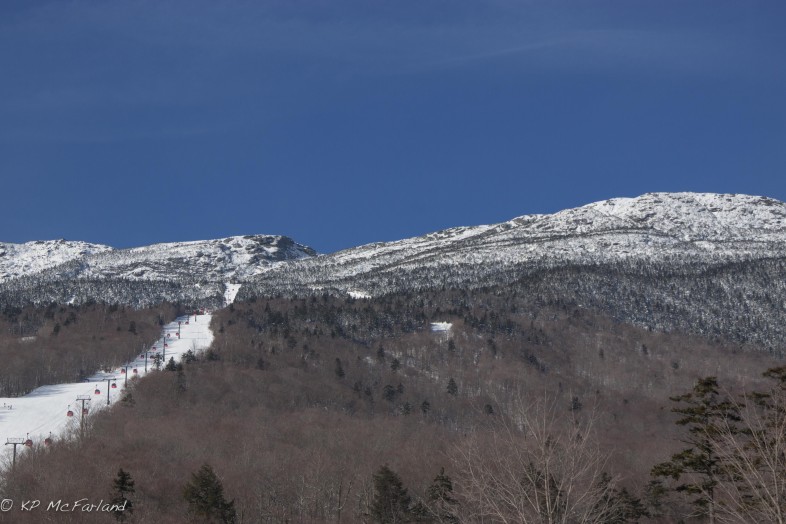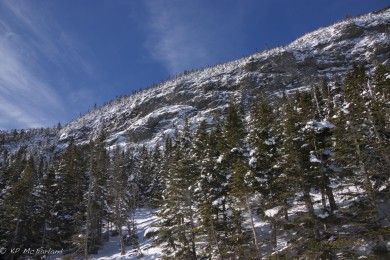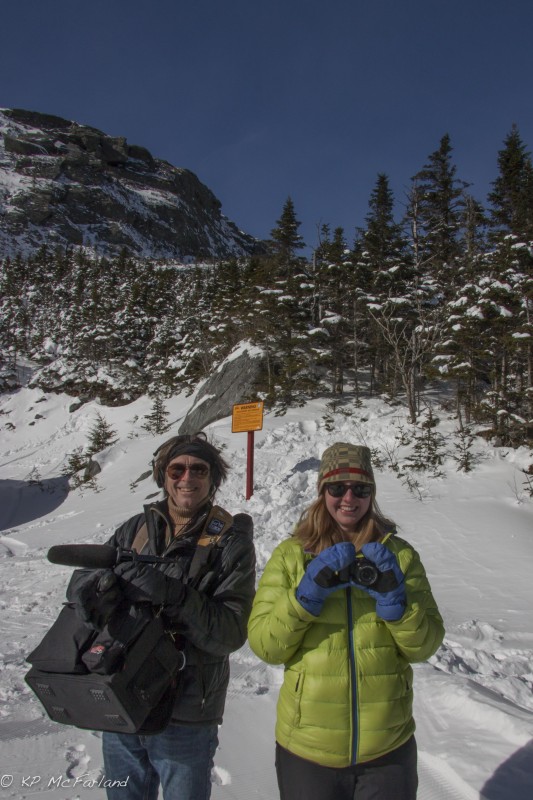When you’re on a ski lift or hiking up one of Vermont’s mountains see if you can spot the different forest types while you climb up the mountainside. Outdoor Radio hosts Sara Zahendra and Kent McFarland recently rode the gondola at Stowe Mountain Resort to check out the trees on Vermont’s highest peak, Mount Mansfield.
Listen to Outdoor Radio
Depending on the elevation and even on which direction the slope is facing, there are different kinds of trees. At the bottom of the mountain, we have a typical northern hardwood forest – beech, maple, birch. But as we go up the mountain, we’ll find more and more evergreen trees until at the top of the lift, we’ll be in the montane fir forest – balsam fir, red spruce and heart-leaved paper birch.
We’ve climbed into another climate. Elevation zones for trees are strongly influenced by temperature, mostly growing season temperatures. As we go up in elevation, it gets colder. That’s called the lapse rate. So, if you are headed out for a ski and you know the temperature at the base, you can get an idea of what it might be like higher up with an easy calculation. On a dry day, add 5.5 F for each 1,000 ft elevation gain and on a wet day, make it 3.3F per thousand feet.
Balsam fir needles can withstand something like -75F. But red spruce can only withstand long hours of freeze above about -25F. So up here, it is getting into the edge of its favored climatic zone. In the 1980s scientists noticed that spruce were dying back at high elevations and scientists right here in Vermont helped to find the reason. The culprit turned out to be acid precipitation.
The acidic cloud water, rain, and snow, leaches calcium from the cell walls of the needles. This lowers the freeze tolerance. So, instead of -25 F, maybe red spruce can only withstand 24 hours of -20 F. And the symptom you see when this starts to happen is all the newer growth on the ends the trees turn red. In 2003 there was a huge freeze event and you could pick out all the red spruce as it was burnt red across the mountains. The good news is, red spruce lately seems to be doing better. Whether that is from cleaner air or warmer air (or both) is not known yet.
An 80 year old fir tree is an old tree. In fact, look across the hillside. Some places you can see little groups of dead fir trees, sort of shaped like a crescent. It isn’t very pronounced in the Green Mountains, but if you are in the Adirondacks or the Whites it is really obvious. These are called fir waves.
Fir waves move very slowly, over decades, in the direction of the prevailing wind. Wind velocity at the edge of the tree canopy is way higher than within the forest. And add rime ice and snow on the trees and they can really get rocking in the wind. Rime ice forms on the trees when water droplets in the air hit solid surfaces and immediately freeze. It accumulates more on trees exposed to wind. The rocking causes their fine rootlets to break. These rootlets are important for delivering nutrients to the tree. As these trees die standing, adjacent trees experience the same conditions and begin to die. The overall direction of the wave motion is therefore directly related to wind direction.
Regeneration of waves occurs at about 60 year intervals. As you move back from the dying front of trees the trees are older and older until you reach the following wave of dead trees. If you were to take time lapsed photography of a mountain side, the waves of dead trees would appear to be moving across the mountainside like a wave in the ocean.
Learn more
- See a map of where Balsam Fir and Red Spruce have been reported by citizen scientists across Vermont on iNaturalist Vermont, a project of the Vermont Atlas of Life. You can even add your sightings to the map!
- VCE blog about Balsam Fir
- Blog: Red Spruce Reviving in New England, But Why?
- Further Reading
Outdoor Radio is a monthly feature produced in collaboration with Vermont Public Radio. The program is made possible by the VPR Journalism Fund and by a grant to VCE from the Vermont Community Foundation. The program is produced and edited by VPR’s Chief Production Engineer, Chris Albertine.




I learned a lot from this episode! Very interesting. Keep up the good work.